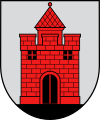Panevežys
| Panevėžys | |||
|---|---|---|---|
| City municipality | |||

Panorama overlooking Panevėžys
|
|||
|
|||
| Nickname(s): Aukštaitijos sostinė (Capital of Aukštaitija, Lietuvos Čikaga (Chicago of Lithuania), Čikaga prie Nevėžio (Chicago at Nevėžis) | |||
| Location of Panevėžys | |||
| Coordinates: 55°44′N 24°21′E / 55.733°N 24.350°ECoordinates: 55°44′N 24°21′E / 55.733°N 24.350°E | |||
| Country |
|
||
| Ethnographic region | Aukštaitija | ||
| County |
|
||
| Municipality | Panevėžys city municipality | ||
| Capital of |
Aukštaitija (unofficial) Panevėžys County Panevėžys city municipality Panevėžys district municipality Panevėžys rural eldership |
||
| First mentioned | 1503 | ||
| Granted city rights | 1837 | ||
| Area | |||
| • Total | 52 km2 (20 sq mi) | ||
| Elevation | 50 m (160 ft) | ||
| Population (2016) | |||
| • Total | 98,598 | ||
| • Density | 1,900/km2 (4,900/sq mi) | ||
| Time zone | EET (UTC+2) | ||
| • Summer (DST) | EEST (UTC+3) | ||
| Postal code | 35xxx | ||
| Area code(s) | (+370) 45 | ||
| Website | www |
||
Panevėžys (Lithuanian pronunciation: [pɐn̪ʲɛvʲeːˈʒʲiːs̪], Polish: Poniewież, Yiddish: פּאָנעװעזש Ponevezh) see also other names, is the fifth largest city in Lithuania. As of 2011, it occupied 52 square kilometres (20 sq mi) with 113,653 inhabitants.
The largest multifunctional arena in Panevėžys, Cido Arena, hosted the Eurobasket 2011 group matches.
Panevėžys was first mentioned in 1503, in documents signed by the Grand Duke of Lithuania Alexander I, who granted the town building rights to construct a church and other structures. Alexander II is considered the founder of the city, which celebrated its 500th anniversary in 2003. The city lies on the old plain of the Nevėžis River. The city name means "along the Nevėžis." Throughout the 16th century, the city maintained a status of a Royal town. Communities of Poles, and Karaites, settled in the area as early as the 14th century. A Karaite Kenesa, and a Polish Gymnasium, existed in Panevėžys until the Second World War (the Polish version of the name of the city was Poniewież). In the 17th century, the part of the city on the left bank of the river started to develop and expand further. The town played an important role in both the November Uprising, and the January Uprising, and the fights for independence continued there in 1864. After the Industrial Revolution, at the end of the 19th century, the first factories were established in the city, and industry began to make use of modern machinery. As products were oriented towards the mass market, banking intensified and commerce increased. The educational system became more accessible, and literacy increased, as well. By the end of 19th century - the beginning of the 20th century, Panevėžys became a strong economic and cultural center of the region. At the time it was the fourth most important city in Lithuania. It was also a center of operations by local knygnešys. One of them - Juozas Masiulis in 1905 opened first Lithuanian bookstore and printing house. The building is still a landmark of Panevėžys, and local people are proud of a bookstore that has been functional for more than 100 years.
...
Wikipedia



